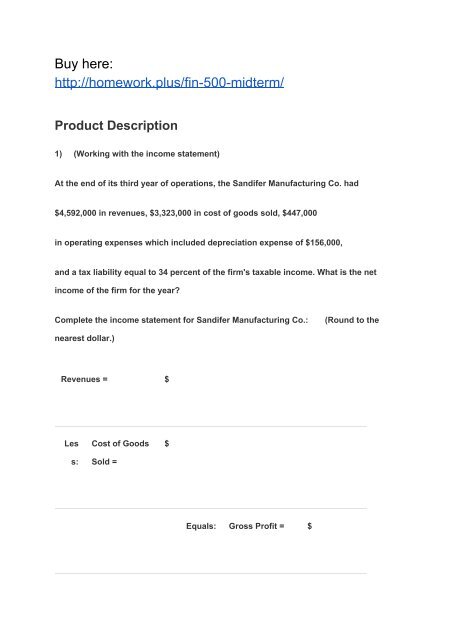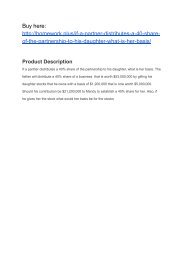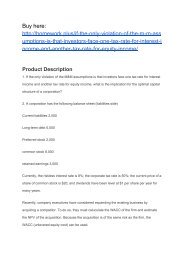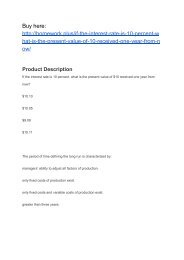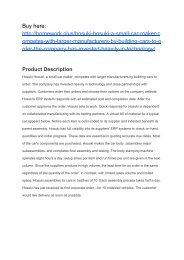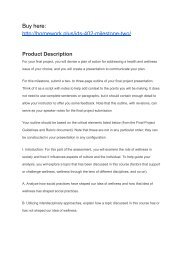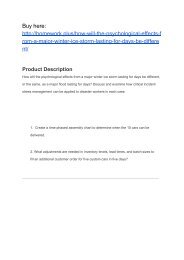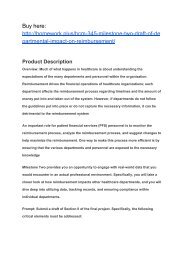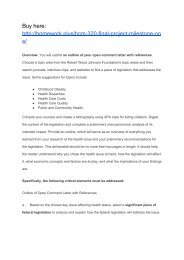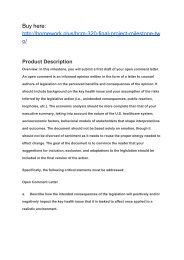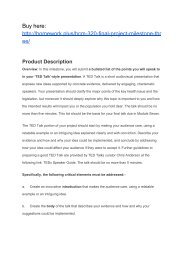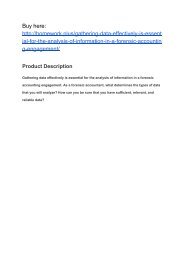FIN 500 Midterm
FIN 500 Midterm
FIN 500 Midterm
Create successful ePaper yourself
Turn your PDF publications into a flip-book with our unique Google optimized e-Paper software.
Buy here:<br />
http://homework.plus/fin-<strong>500</strong>-midterm/<br />
Product Description<br />
1) (Working with the income statement)<br />
At the end of its third year of operations, the Sandifer Manufacturing Co. had<br />
$4,592,000 in revenues, $3,323,000 in cost of goods sold, $447,000<br />
in operating expenses which included depreciation expense of $156,000,<br />
and a tax liability equal to 34 percent of the firm's taxable income. What is the net<br />
income of the firm for the year?<br />
Complete the income statement for Sandifer Manufacturing Co.:<br />
(Round to the<br />
nearest dollar.)<br />
Revenues = $<br />
Les<br />
s:<br />
Cost of Goods<br />
Sold =<br />
$<br />
Equals: Gross Profit = $
Les<br />
s:<br />
Operating<br />
Expenses =<br />
$<br />
Equals:<br />
Net Operating<br />
Income =<br />
$<br />
Les<br />
s:<br />
Interest<br />
Expense =<br />
$ 0<br />
Equals:<br />
Earnings before<br />
Taxes =<br />
$<br />
Les<br />
s:<br />
Income Taxes<br />
=<br />
$<br />
Equals: Net Income = $<br />
Enter any number in the edit fields and then continue to the next question.
2)<br />
Balance<br />
2013<br />
Sheet<br />
Cash and<br />
$490<br />
marketable<br />
securities<br />
Accounts<br />
5,970<br />
receivable<br />
Inventories 9,480
Current<br />
15,940<br />
assets<br />
Net<br />
property<br />
16,960<br />
plant and<br />
equipment<br />
Total<br />
$32,900<br />
assets<br />
Accounts<br />
$7,150<br />
payable<br />
Short-term<br />
6,840<br />
debt
Current<br />
$13,990<br />
liabilities<br />
Long-term<br />
6,980<br />
liabilities<br />
Total<br />
20,970<br />
liabilities<br />
Total<br />
11,930<br />
owners'<br />
equity<br />
Total<br />
32,900<br />
liabilities<br />
and<br />
owners'<br />
equity
Income<br />
2013<br />
Statement<br />
Revenues $29,960<br />
Cost of goods<br />
sold (19,950)<br />
Gross profit $10,010<br />
Operating<br />
(7,950)<br />
expenses<br />
Net operating<br />
income $2,060<br />
Interest expense (870)
Earnings before<br />
$1,190<br />
taxes<br />
Taxes (433)<br />
Net income $757
The balance sheet and income statement for Carver Enterprises, Inc. are<br />
foundhere:<br />
.<br />
a. Prepare a common-size balance sheet for Carver Enterprises.<br />
b. Prepare a common-size income statement for Carver Enterprises.<br />
a. Prepare a common-size balance sheet for Carver Enterprises.<br />
Complete the common-size balance sheet below:<br />
(Round to one decimal place.)<br />
Common-<br />
2013<br />
Size
Balance<br />
Sheet<br />
Cash and<br />
$ 490 %<br />
marketabl<br />
e<br />
securities<br />
Accounts<br />
5,970<br />
receivable<br />
Inventorie<br />
9,480<br />
s<br />
Current<br />
assets<br />
$ 15,94<br />
0<br />
%
Net<br />
property<br />
16,96<br />
0<br />
plant and<br />
equipmen<br />
t<br />
Total<br />
assets<br />
$ 32,90<br />
0<br />
%<br />
Accounts<br />
$ 7,150 %<br />
payable<br />
Short-ter<br />
6,840<br />
m debt<br />
Current<br />
liabilities<br />
$ 13,99<br />
0<br />
%
Long-ter<br />
6,980<br />
m<br />
liabilities<br />
Total<br />
liabilities<br />
$ 20,97<br />
0<br />
%<br />
Total<br />
owners’<br />
equity<br />
11,93<br />
0<br />
Total<br />
liabilities<br />
and<br />
owners’<br />
equity<br />
$ 32,90<br />
0<br />
%<br />
b. Prepare a common-size income statement for Carver Enterprises.
Complete the common-size income statement below:<br />
(Round to one decimal<br />
place.)<br />
Common-Size Income<br />
2013<br />
Statement<br />
Revenues $ 29,960 %<br />
Cost of goods sold (19,950)<br />
Gross profit $ 10,010 %<br />
Operating expenses (7,950)<br />
Net operating income $ 2,060 %<br />
Interest expense (870)
Earnings before taxes $ 1,190 %<br />
Taxes (433)<br />
Net income $ 757 %<br />
3) (Present-Value Comparison) Much to your surprise, you were selected to appear on<br />
the TV show "The Price is Right." As a result of your prowess in identifying how many<br />
rolls of toilet paper a typical American family keeps on hand, you win the opportunity<br />
to choose one of the following: 2,000 today, 9,000 in 9 years, or $ 32,000<br />
in 24 years. Assuming that you can earn 12 percent on your money, which should you<br />
choose?<br />
If you are offered $9,000 in 9 years and you can earn 12<br />
percent on your money, what is the present value of<br />
$9,000?
$<br />
(Round to the nearest cent.)<br />
If you are offered 32,000 in 24 years and you can earn<br />
12percent on your money, what is the present value of<br />
$32,000?<br />
$<br />
(Round to the nearest cent.)<br />
Which offer should you choose?<br />
(Select the best choice below.)<br />
A.Choose<br />
$32,000.00 in 24 in 24 years because its present value is the highest.<br />
B.Choose<br />
$2,000.00 today because its present value is the highest.
C.Choose<br />
9,000.00 in 9 years in because its present value is the highest.<br />
4)( Future value of an ordinary annuity) You are graduating from college at<br />
the end of this semester and after reading the The Business of Life box in this<br />
chapter, you have decided to invest 4,100 at the end of each year into a Roth IRA for<br />
the next 41 years. If you earn 6 percent compounded annually on your investment,<br />
how much will you have when you retire in 41 years? How much will you have if you<br />
wait 10 years before beginning to save and only make 31 payments into your<br />
retirement account?<br />
How much will you have when you retire in<br />
41 years?<br />
$<br />
(Round to the nearest cent.)<br />
How much will you have if you wait 10 years before beginning to save and only make<br />
31payments into your retirement account?<br />
$<br />
(Round to the nearest cent.)
5) ( Annuity Payments) Mr. Bill S. Preston, Esq., purchased a new house for 130,000.<br />
He paid $30,000 upfront and agreed to pay the rest over the next 10 years in 10 equal<br />
annual payments that include principal payments plus 13 percent compound interest<br />
on the unpaid balance. What will these equal payments be?<br />
a. Mr. Bill S. Preston, Esq., purchased a new house for 130,000 and paid<br />
$30,000 upfront. How much does he need to borrow to purchase the house?<br />
$<br />
(Round to the nearest dollar.)<br />
b. If Bill agrees to pay the loan over the next 10 years in 10 equal end-of-year<br />
payments plus 13<br />
percent compound interest on the unpaid balance, what will these equal payments<br />
be?<br />
$<br />
(Round to the nearest cent.)<br />
6) ( Annuity Payments) Lisa Simpson wants to have 1,100,000 in 50 years by making<br />
equal annualend-of-the-year deposits into a tax-deferred account paying 8.00 percent<br />
annually. What must Lisa's annual deposit be?The amount of Lisa's annual deposit<br />
must be
$<br />
7) (Calculating rates of return) The S&P stock index represents a portfolio<br />
comprised of <strong>500</strong> large publicly traded companies. On December 24, 2007, the index<br />
had a value of 1,410 and on December 24, 2008, the index was approximately 929. If<br />
the average dividend paid on the stocks in the index is approximately 4.5 percent of<br />
the value of the index at the beginning of the year, what is the rate of return earned on<br />
the S&P index? What is your assessment of the relative riskiness of investing in a<br />
single stock such as Google compared to investing in the S&P index (recall from<br />
Chapter 2 that you can purchase mutual funds that mimic the returns of the index)?<br />
The rate of return earned on the S&P <strong>500</strong> is_____ (Round to two decimal places.)<br />
What is your assessment of the relative riskiness of investing in a single stock, such<br />
as Google, compared to investing in the S&P index? (Select the best choice below.)<br />
A.<br />
In general, investing in a single stock is riskier than investing in the S&P index.<br />
B.<br />
In general, investing in a single stock has the same relative riskiness as investing in<br />
the S&P index.<br />
C.
There is not enough information given to answer this question.<br />
D.<br />
In general, investing in the S&P index is riskier than investing in a single stock<br />
8) James Fromholtz is considering whether to invest in a newly formed investment<br />
fund. The fund's investment objective is to acquire home mortgage securities at what<br />
it hopes will be bargain prices. The fund sponsor has suggested to James that the<br />
fund's performance will hinge on how the national economy performs in the coming<br />
year. Specifically, he suggested the following possible outcomes<br />
State of Economy Probability Fund<br />
Returns<br />
Rapid expansion and recovery 5%<br />
100%<br />
Modest growth 35% 40%<br />
Continued recession 55% 10%<br />
Falls into depression 5% -100%
Based on these potential outcomes, what is your estimate of the expected rate of<br />
return from this investment opportunity?Would you be interested in making such an<br />
investment? Note that you lose all your money in one year if the economy collapses<br />
into the worst state or you double your money if the economy enters into a rapid<br />
expansion.


